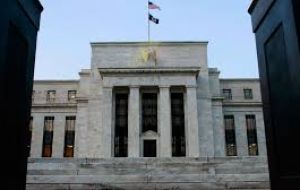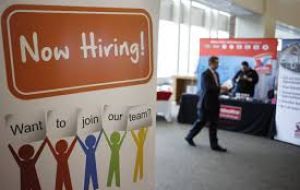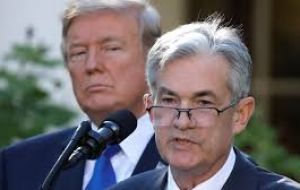MercoPress. South Atlantic News Agency
Fed raises interest rate and announces a third increase this year
 It was the eighth time the FOMC has raised borrowing costs since late 2015. It held rates near zero after the Great Recession to speed up the economic recovery.
It was the eighth time the FOMC has raised borrowing costs since late 2015. It held rates near zero after the Great Recession to speed up the economic recovery.  Chairman Jerome Powell said that the Fed did not have a precise estimate of where “accommodation ends”
Chairman Jerome Powell said that the Fed did not have a precise estimate of where “accommodation ends”  Mortgage rates are rising, but strong demand for housing has meant the impact is still minimal. Savers should also see their interest rates increase
Mortgage rates are rising, but strong demand for housing has meant the impact is still minimal. Savers should also see their interest rates increase  The economy is strong: “growth running at a healthy clip, unemployment is low, the number of people working is steadily rising, and wages are up”, Powell said
The economy is strong: “growth running at a healthy clip, unemployment is low, the number of people working is steadily rising, and wages are up”, Powell said  Asked about Trump's criticism of the Fed rate hikes he simply said: “We don't consider political factors or things like that”.
Asked about Trump's criticism of the Fed rate hikes he simply said: “We don't consider political factors or things like that”. The United States Federal Reserve announced on Wednesday, after a two-day policy meeting, that it would raise interest rates for the third time this year. The decision, which had been widely expected, raised the federal funds rate by 25 basis points, to a range of 2% to 2.25%.
It was the eighth time the Federal Open Market Committee has raised borrowing costs since late 2015. It held rates near zero after the Great Recession to speed up the economic recovery.
The Federal Open Market Committee removed language in its statement that had characterized its policy as “accommodative.” Still, Fed Chairman Jerome Powell said at a press conference that the Fed did not have a precise estimate of where accommodation ends. It maintained its forecast for three rate hikes next year, even after President Donald Trump last month complained about higher interest rates.
Short-term interest rates are most affected by Fed decisions, meaning rates on things like credit cards should rise soon after Wednesday. Mortgage rates are rising, but strong demand for housing has meant the impact is still minimal. Savers should also see their interest rates increase, though banks tend to lift these slower than they do for borrowers.
The Fed's statement again struck a bullish tone on the economy, “Our economy is strong,” Powell said. “Growth is running at a healthy clip, unemployment is low, the number of people working is steadily rising, and wages are up.”
Fed officials raised their forecast for gross domestic product next year by 0.1 percentage points, to 2.5%. And for the first time, they released a projection for growth in 2021, which stood at 1.8%.
The voting FOMC members released a new projection for where they see rates over the next two years and in the long run, known as the dot plot. Their new dot plot maintained the forecast for one more rate hike this year, most likely in December, and three in 2019, though the range of expectations widened.
Some economists have urged the Fed to be even more patient with hiking because short-term rates could soon tip over longer-term ones, which are normally higher. The yield difference between two- and 10-year Treasury's shrank to an 11-year low of 21 basis points last week; a so-called yield curve inversion happens when it goes negative and is used as a recession signal.
During Powell's press conference, he was asked about the economic risks of a trade war. He downplayed the threat during congressional testimony in July, but Trump has since imposed tariffs on an additional US$ 200 billion worth of Chinese goods and threatened to impose duties that would cover half of all imports from the world's second-largest economy.
“More than anything though, I would worry in the longer run where this is going,” Powell said. “If the end place we get to is lower tariffs, that would be good.”
He added that more protectionism would be bad for workers and the US economy and asked about Trump's criticism of the Fed rate hikes he simply said: “We don't consider political factors or things like that”.
Full FOMC statement:
Information received since the Federal Open Market Committee met in August indicates that the labor market has continued to strengthen and that economic activity has been rising at a strong rate. Job gains have been strong, on average, in recent months, and the unemployment rate has stayed low. Household spending and business fixed investment have grown strongly. On a 12-month basis, both overall inflation and inflation for items other than food and energy remain near 2 percent. Indicators of longer-term inflation expectations are little changed, on balance.
Consistent with its statutory mandate, the Committee seeks to foster maximum employment and price stability. The Committee expects that further gradual increases in the target range for the federal funds rate will be consistent with sustained expansion of economic activity, strong labor market conditions, and inflation near the Committee's symmetric 2 percent objective over the medium term. Risks to the economic outlook appear roughly balanced.
In view of realized and expected labor market conditions and inflation, the Committee decided to raise the target range for the federal funds rate to 2 to 2-1/4 percent.
In determining the timing and size of future adjustments to the target range for the federal funds rate, the Committee will assess realized and expected economic conditions relative to its maximum employment objective and its symmetric 2 percent inflation objective. This assessment will take into account a wide range of information, including measures of labor market conditions, indicators of inflation pressures and inflation expectations, and readings on financial and international developments.
Voting for the FOMC monetary policy action were: Jerome H. Powell, Chairman; John C. Williams, Vice Chairman; Thomas I. Barkin; Raphael W. Bostic; Lael Brainard; Richard H. Clarida; Esther L. George; Loretta J. Mester; and Randal K. Quarles.




Top Comments
Disclaimer & comment rulesCommenting for this story is now closed.
If you have a Facebook account, become a fan and comment on our Facebook Page!